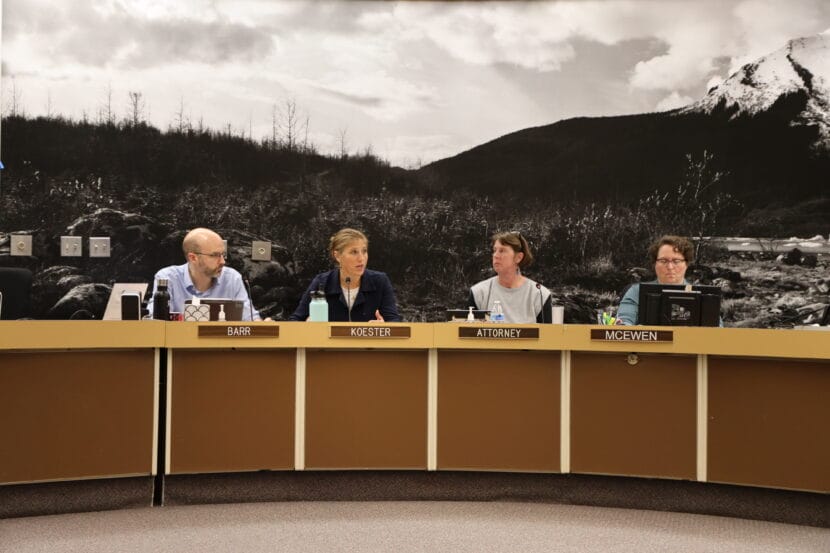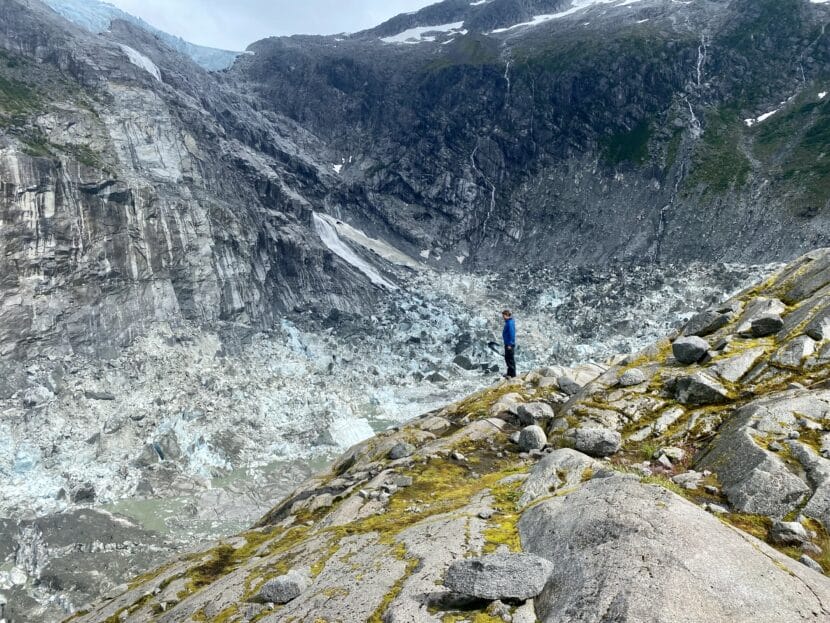
City leaders say they’re working with federal partners on strategies to endure a future of flooding in the Mendenhall Valley, following a second year of record-breaking flooding.
At Monday’s Juneau Assembly Committee of the Whole meeting, City Manager Katie Koester said the last two years of catastrophic glacial outbursts have changed the community’s understanding of what can flood. Two years ago, only about two dozen homes were affected. This year, nearly 300 homes were damaged.
“Most communities that deal with flooding, they’re dealing with flooding over time, increased flooding — we have really gone from zero to 100 overnight,” Koester said. “All of those things just underscore the need for action, both in the near-term and the long-term.”
Juneau officials met with a number of state and federal agencies in Anchorage late last week to discuss ways to better understand — and possibly prevent — glacial outburst floods in the future.
The Alaska Department of Transportation, Central Council of the Tlingit and Haida Indian Tribes of Alaska, National Weather Service, U.S. Geological Survey, U.S. Forest Service, National Resources Conservation Service, U.S. Army Corps of Engineers and representatives from the offices of Senators Lisa Murkowski and Dan Sullivan were in attendance.
On Monday, the Assembly discussed short-term plans to set aside money for updated flood maps and a new hydrologic study of the Mendenhall River, which would help homeowners better understand risks in their neighborhood. They’re also considering hiring an additional staff member for the city’s emergency management department.
Many in the community are also hoping for a way to prevent severe flooding altogether. The Assembly discussed some possible ways to do that at a meeting last month. But Koester said the meeting in Anchorage underscored a need for more research to move forward, and she said no major flood prevention project would be feasible over the next year.
“No one solution is going to control flooding, right? It’s going to need to be a combination of levee, a combination of some channelizing, maybe some hardening to protect the bank,” Koester said. “It became pretty obvious that there’s no short-term construction solution — you know, trenching, building — that could be done successfully before next summer.”
Meanwhile, Suicide Basin is already filling again, which means another flood might be possible even sooner than that. Koester and city officials expressed concern about that possibility, saying they’re not prepared for another flood to happen this fall.

Meteorologist Nicole Ferrin with the National Weather Service said it is not unheard of for the basin to release multiple times in one season. In fact, the basin drained last September, after August’s outburst flood. But it released relatively little water, which was largely unnoticed.
“But what is happening right now is unusual,” Ferrin said. “The basin always refills some in the fall time, but it doesn’t usually keep refilling to the level it’s at right now.”
Currently, water levels in the basin are similar to where they were in June of this year. If water were to drain right now, the Mendenhall River would only reach a minor flood stage, inundating portions of the Skater’s Cabin road.
Typically, as the summer turns to fall, the rate of water filling the basin slows down as rain in the mountains becomes snow, and cooler temperatures slow the melting of ice. Ferrin said the likelihood of another catastrophic flood this year is low.
“If we get multiple rain events back to back to back to back and then it releases, you know, I wouldn’t rule it out,” Ferrin said. “But I would rather alleviate people’s fears by saying it’s not imminent. Major flooding is not imminent, but we are monitoring it, and people should stay aware.”
Still, the filling of the basin is a reminder of the need for swift action. The city has already allocated $300,000 set aside from an emergency appropriation and this year’s capital improvement budget that can be put towards studying and mapping Mendenhall River flooding, which they hope to do this winter. They need a plan to allocate an additional $100,000 to cover the cost of that work, which they plan to introduce by their next regular Assembly meeting.
The city also hopes to create a plan for flood fighting and emergency response before water returns next year. Koester said Sen. Murkowski is working on a piece of national legislation on emergency response funding, which may eventually free up federal money to support that work.
And the salary of new emergency management personnel would be covered by money that was previously allocated for a city-sponsored finance position at the Juneau School District. That hiring decision does not fall to the Assembly, but member Christine Woll expressed support for the idea.
“Obviously disaster relief is front of mind given the last few years, and given the flood,” Woll said. “We also know it’s going to get worse in the future, and we need to be able to not only respond, but proactively plan — and landslides are on my mind too.”
Human-caused climate change is bringing warmer temperatures and more extreme weather events to Southeast Alaska, which could make disasters in Juneau more common.
When it comes to glacial outburst flooding, the bigger financial lift will be the study of major flood prevention projects, which might involve construction to alter Suicide Basin, Mendenhall Lake or the greater Mendenhall River flood plain.
Koester said the U.S. Army Corps of Engineers has a program to pursue projects like that, but it’s pricey. Koester says engaging the Corps will require the city to secure $3 million of local funding, and an additional $3 million in federal funding.
The Assembly said they’re committed to allocating that local funding by pulling from appropriations for other planned city projects. But they’ll discuss it further at their regular Assembly meeting next Monday, Sept. 16.
Monitor the latest Suicide Basin conditions here.